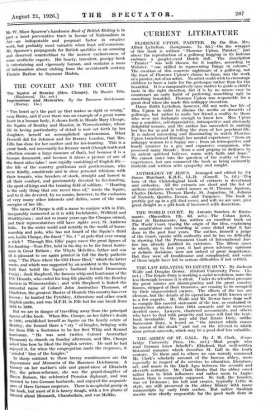BOOKS ON ART AND ARTISTS
Corot. By Marc Lafargue, translated by Lindsay Wellington. (The Bodley Head. 5s. )- Van Gogh. By Paul Colin, translated by Beatrice laoggridge. (The Bodley Head. 5s.) Some French Artists of the Nineteenth Century. By Frank Gibson. (Robert Scott. 15s.) Dutch Painting of the XVIIth Century. By C. H. Winn Baker. (The Studio. 10s. 6d.) A Dictionary of Painters of Miniatures. By J. J. Fog{ r. (Philip Allan. 21s.) A GREAT number of people of good will towards Modern Art find themselves unable to understand, or even to get contact with, its varied and contradictory manifestations by their own intuitive perceptions. Mr. Rutter's analysis of the genesis and intentions of Post-Impressionism, Cubism, Futurism and other theories will be welcomed by these, and should clear up a good deal of common misunderstanding. It is for the most part clearly written, offers a good summary of the writings and sayings of propagandists and painters, and contains a well. chosen series of reproductions.
Mr. Rutter begins his book with a series of Propositions, of which the gist is that there can be no Art without Life, no Life without 'Growth, and no Growth without Change ; and that there can never be any standardized method of conveying Emotion. Beginning with the legacy of Impressionism," the case for later movements is stated with much fairness, though among English Modernists there is no mention of Duncan Grant or Frank Dobson, and Mr. Clive Bell's book, Art, is oddly omitted from the bibliography. Mr. Rutter emphasizes the interest to the historian of a study of modern Art as an index to the psychology of Europe at a momentous period, but some of his generalizations are far from sound in their mixture of aesthetic judgments with social and political assumptions. It is a pity that a book dealing largely with design should be sent out with so irritating and mechanical a pattern on its covers ; however, it is a good popular exposition of ideas and feelings which have deeply moved artists in our time.
Illustrations in books on Art are far more important than text, and the forty reproductions in each of the Bodley Head monographs on Corot and Van Gogh include some fascinating and little known examples, though the quality of the blocks is often poor. The introduction on Van Gagh is especially interesting. Mr. Gibson's amiable essays on Six French Artists, as well known as Delacroix and Millet and as blameless as Cazin, accompanied by only twelve illustrations, seem curiously belated to-day, and scarcely justify their publication.
Professor A. M. Hind's Rode Lecture of 1926 is stimulating as well as scholarly in recalling links of style and vision between Claude Lorrain and modern artists.
Into his excellent survey of Dutch painting in its greatest period, Mr. G. H. Collins Baker has packed an immense amount of information, written in a lively and trenchant style. Articles on Copley, Fielding and J. F. Lewis, RA., and some delightfully personal notes on Sargent by Mr. Adrian Stokes are to be found in the third annual volume of the Old Water Colour Society's Club.
Miniature painting owes its popularity to the interest of human associations, to the records it gives of people, and the a
timate flavour of periods that clings to it. The book by Dr. G. C. Williamson and Mr. Buckman gives an historical and technical survey of the art, with notes on old pigments, and hints on practice. The illustrations from Holbein to the present day include some superb examples and show how the art has suffered from the imitation of its own prettiness, and from relying over much on its special attractions and the taste of its patrons rather than on the qualities of observation, draughtsmansbiP and style, common to all fine portraiture. Mr. J. J. Fosteis Dictionary of Miniature Painters is an admirable work of reference, of little general interest, without _illustrations.
ti
Ii
ti ei
hi a,
lx
ill
or al
1)1 Mr. W. Shaw Sparrow's handsome Book of British Etching is in part a Most provocative tract in favour of Nationalism in Art—an indisputable and pregnant factor in creative work, but probably most valuable when least self-conscious. Mr. Sparrow's propaganda for British qualities is an amusing and deserved counterblast to the narrow exclusiveness of some aesthetic experts. His hearty, truculent, gossipy book is entertaining and vigorously human, and contains a mass of information about etching from the seventeenth century Francis Barlow. to Seymour linden.



































 Previous page
Previous page